Abstract
The article focuses on the research of processes of summation of ultrasonic vibrations of individual Langevin transducers symmetrically arranged on a common summator. This design could be used to solve the problem of increasing the power of a high-frequency ultrasonic radiator by means of the summation of the vibrations of individual Langevin transducers. The results of the presented theoretical and experimental investigations supported the possibility of summation of symmetrical diametrical vibrations when they are transformed into longitudinal vibrations. As a result, a new design scheme for high-frequency radiator construction was developed that provides symmetry and uniformity of vibration amplitude distribution of piezoceramic elements. This made it possible to eliminate the damage of piezoceramic elements. The article establishes that an acoustic power (continuous mode) of 1450 W at an efficiency of 78% is achieved when the vibrations from 9 to 11 of symmetrically arranged Langevin transducers at a resonant frequency of 30.05 kHz with an amplitude of 26 µm are summed. The use of this ultrasonic high-frequency radiator with increased power will provide intensification of processes in various areas of industry.
1. Introduction
The development of new ultrasonic technologies is limited by the absence of high-frequency ultrasonic radiators with increased power. Such radiators are relevant for solving the problems of intensification of extraction processes in liquid media [1] and air purification from suspended particles with a size of less than 2.5 µm due to their agglomeration [2,3].
Moreover, ultrasonic vibrations with a frequency of more than 25 kHz and an intensity of more than 10 W/cm2 are known to make it possible to exfoliate emulsions, separate oil from water [3], clean drilling fluids from foreign particles [4], create fine-dispersed mists for spraying homogeneous coatings in the production of electronic (microcircuits and processors), and medical products (coronal stents) [5,6].
Nowadays, the devices for the creation of ultrasonic vibrations are made according to the Langevin design scheme, which provides the conversion of electric energy into the energy of ultrasonic vibrations with maximum efficiency. This scheme includes a radiating element, two or four piezoelectric elements, and a reflecting element that are successively installed, mechanically connected, and acoustically connected. The length of the entire construction corresponds to half the wavelength of ultrasonic vibrations in the transducer materials and determines the resonance frequency of the generated ultrasonic vibrations [7]. The Langevin scheme proved itself in the construction of modern transducers for operating frequencies from 15 to 22 kHz [7,8,9,10,11,12].
However, the development of transducers with an operating frequency of more than 25 kHz, according to the Langevin scheme, is conditioned by a number of technical difficulties. Reduction of the longitudinal resonance size of the elements (which is necessary to provide an increased resonance frequency of the transducer) requires increasing the diameter of such elements (including piezoceramic elements) to maintain or increase the radiated power. The reason is that the power of the generated vibrations is determined by the volume of the piezomaterial used and does not exceed 20 W per 1 cm2 of the piezomaterial for modern materials [13].
Conversely, an increase in the diameter of the piezoceramic elements breaks the symmetry of the transducer vibrations and leads to an increase in parasitic diametrical vibrations and a decrease in the efficiency of the formation of longitudinal vibrations. It is theoretically and experimentally established that the outer diameter of the piezoceramic elements in this design scheme cannot be more than half of the resonant length of the transducer (equal to half the wavelength) [14,15,16].
To solve this problem, the authors earlier proposed to increase the intensity of the radiated ultrasonic vibrations by summing the vibrations of individual transducers arranged on a common radiating element [17,18].
Meanwhile, summing the vibrations of the Langevin transducers on the longitudinally vibrating common summator to create high-frequency transducers is unacceptable because of the vibration symmetry breaking and the appearance of diametrical vibrations in the summator itself. Breaking of symmetry increases mechanical stresses in the transducer material to critical values, leading to its failure. This occurs when the diameter of the summator exceeds a quarter of the wavelength of the formed vibrations in the element material.
To eliminate the drawbacks of existing designs and increase the specific density of radiating energy, we proposed to use diametrical vibrations (considered parasitic in Langevin transducers) of the common summator. For this purpose, high-frequency vibrations generated by symmetrically and radially arranged Langevin transducers are summed on the element. The element is made in the form of a cylinder, the diameter and height of which correspond to half the wavelength of ultrasonic vibrations in the element material. In such a design scheme, the radiating element performs simultaneously the functions of the summator of symmetrically formed vibrations and the transducer of diametrical vibrations into longitudinal vibrations [17].
2. High-Frequency Radiator Design for Power Summation of Symmetrically Arranged Langevin Transducers
The design of an ultrasonic high-frequency radiator, providing the summation of vibrations of symmetrically arranged Langevin transducers is shown in Figure 1 [17].
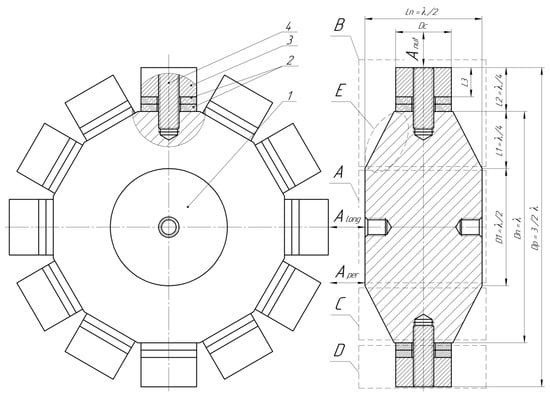
Figure 1.
High-frequency radiator design with increased power and symmetrically arranged Langevin transducers: (1) summator; (2) piezoceramic elements; (3) reflective elements; and (4) connecting pins.
The radiator consists of a summator (item 1), radially and symmetrically arranged piezoceramic elements (item 2), a reflective element (item 3), and connecting pins (item 4).
Area A of the summator (item 1) with diameter D1 and length Ln is a transducer of diametric vibrations into longitudinal vibrations. Two piezoelectric elements (item 2), a reflective element (item 3), and a connecting pin (item 4) represent a piezoelectric packet (area D). The emitter contains n piezoelectric packet (area D). The piezoelectric packet (area D) and the part of the summator (area C) with thickness L1 act as a Langevin transducer (area B).
Area A of the summator (item 1) summarizes the symmetric vibrations of radially arranged Langevin piezoelectric transducers (area B) by forming diametric tensions and compressions. The resulting diametrical vibrations lead to the formation of longitudinal vibrations. Moreover, the amplitude on the end surfaces (ALONG) depends both on the amplitude of vibrations of symmetrically arranged Langevin piezoelectric transducers (area B) and on the transformation coefficient of the summator (area A). This coefficient depends on the ratio between the dimensions D1 and Ln as well as on the number of piezoelectric packets (area D). The force created on the end surface of the radiating element is proportional to the sum of forces (power) created by all transducers symmetrically arranged along the summator. To increase the strength and simplify the design of the transducer, the profile shape of the summator is made conical (region E).
By means of modal analysis using the finite element method, the optimum diameter/length ratio (M = Dn/Ln) of the summator was established in order to ensure the maximum amplitude of vibrations at the radiating surface. The obtained dependence of the transformation coefficient on the diameter/length ratio (M = Dn/Ln) is shown in Figure 2 [17].
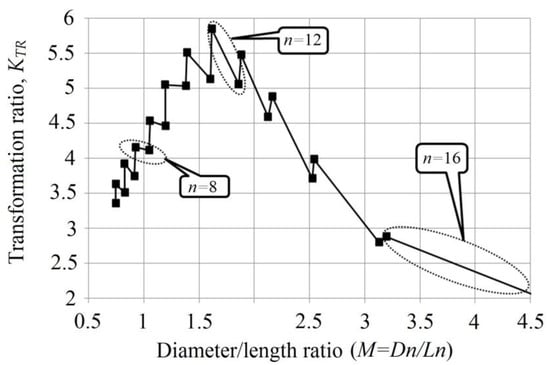
Figure 2.
Dependence of the piezoelectric transducer transformation coefficient (KTR = Along/Anut) on the ratio (M = Dn/Ln).
The optimum ratio of the M value that provides the maximum amplitude was 1.6. A total of 12 piezoelectric packets are installed symmetrically on the transducer with respect to the acoustic axis (area D, Figure 1).
The jumps in the transformation coefficient in the graph (Figure 2) are caused by the appearance of gaps between the Langevin transducers when the diameter of the radiating element increases, but the number (n) of Langevin transducers connected remains unchanged until there is enough gap to install the next transducer (i.e., the diameter of the radiating element changes continuously, but the number of Langevin transducers is discrete).
3. Research of the Radiator’s Functionality and Optimization of Its Design
In the process of determining the functionality of the developed radiator with a conical transition and an axisymmetrical arrangement of Langevin transducers, an experimental sample of the radiator with a resonance frequency of 30 kHz was calculated and manufactured, and its resource tests were conducted.
A photograph of the manufactured transducer assembled with a cylindrical radiator (for radiation into water) is shown in Figure 3.
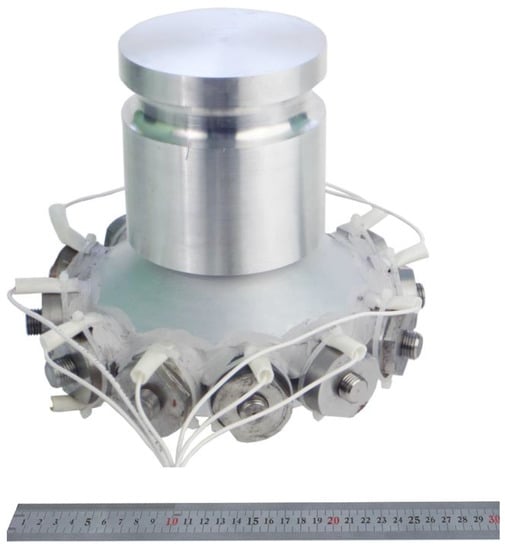
Figure 3.
Transducer assembled with a cylindrical radiator.
Table 1 shows the results of measurements of the transducer power characteristics with a symmetrical arrangement of piezoelectric elements.

Table 1.
The results of the measurement of the transducer power characteristics.
The research established that after 7–10 h of operation at full power (1800 W), the resonance frequency of the radiator decreased by 150 Hz. Meanwhile, the impedance at resonance also increased from 10 to 15 ohms. After the transducer was disassembled and the condition of the individual elements of the radiator was visually assessed, diametrical cracks were found in the majority of piezoceramic disks (21 out of 24).
The most probable reason for the appearance of cracks is the asymmetry of the vibration amplitude distribution of the summator in piezoelectric packets. The rigid design of the summator with a conical transition during the vibrations forms a diametrical bending on the boundary of the ceramic summator. Therefore, this causes the asymmetry of vibrations. Meanwhile, the vibration amplitude of the central part of the connection planes (the planes between area C and area D in Figure 1) of the summator is significantly greater than the peripheral one. As a result, the symmetry of the formed vibrations is broken, and bending vibrations of the piezoceramic disks occur, which lead to their damage.
To eliminate the identified cause of piezoceramic element damage, the authors optimized the radiator design to ensure symmetry and uniformity of vibration amplitude distribution of the piezoceramics adjacent to the summator.
As the criterion of optimality, we used the value of the normalized standard deviation (NSD) of the vibration amplitude on the piezoceramic plane, defined by the expression:
where —arithmetic mean of the sample, μm; xi—values of vibration amplitudes within the plane of the piezo-disk, μm, Anut—vibration amplitude in the center of the reflecting element, μm, and k—number of points in the sample. Normalization was carried out according to the vibration amplitude of the reflecting element Anut.
To reduce the asymmetry of vibration distribution in the piezoceramic area, we proposed changing the transition shape of the summator (area E, Figure 1) from conical to radial. Figure 4 shows the modified design of the ultrasonic radiator.
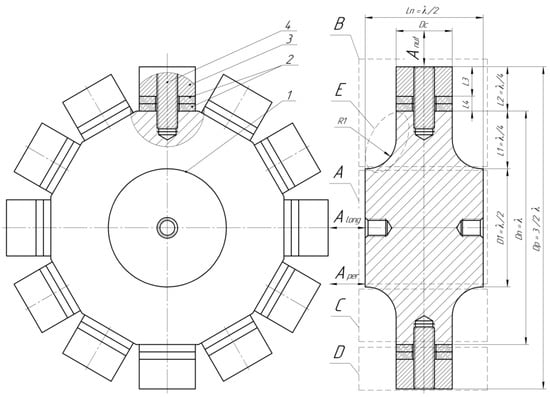
Figure 4.
Modified high-frequency radiator design with increased power and symmetrically arranged Langevin transducers: (1) summator; (2) piezoceramic elements; (3) reflective elements; and (4) connecting pins.
In the next step, the modeling of the modified radiator was carried out. During the calculations, the value of the natural vibration frequency equal to 30,000 ± 50 Hz was provided. The size of D1 remained unchanged. Meanwhile, the diameter of the summator Dn (item 1, Figure 1) was constantly changing and was recalculated. After each calculation, the results were analyzed, and the length (Ln) was corrected to maintain the natural vibration frequency within 30,000 ± 50 Hz.
The material data (density, Young’s modulus, and Poisson’s ratio) used in the calculations are presented in Table 2.

Table 2.
Characteristics of the material used [13,18,19].
A tetrahedral finite element type was used to calculate and analyze the operation of an ultrasonic radiator under a volumetric stress state. The tetrahedral finite element mesh approximates bodies of complex shapes well and provides satisfactory results in modeling physical tasks for objects of arbitrary shape, whose characteristic geometrical dimensions are comparable in three dimensions (length, width, and height). The linear size of the tetrahedral mesh element was 6 mm. The analysis was carried out in the frequency range from 28 to 32 kHz.
At the initial stage, the dependence (Figure 5) of the non-uniformity of vibration amplitude distribution on the piezoceramics (NSD) on the radius (on the ratio of radius/diameter W = R1/Dn) was obtained. According to the dependence shown in Figure 2, modeling was conducted for the most optimal case, in which the maximum vibration amplitude is provided when the number of symmetrically arranged piezoelectric packets is equal to n = 12, at the ratio M = Dn/Ln = 1.6.
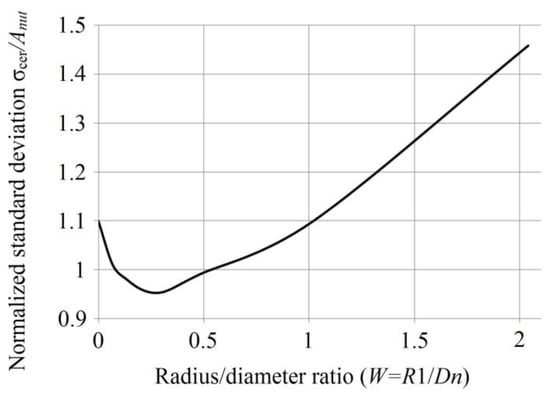
Figure 5.
Dependence of non-uniformity of vibration amplitude distribution on ratio (W = R1/Dn).
Analysis of the obtained data showed that the minimum asymmetry is achieved at the ratio W = R1/Dn = 0.27. Since the modified transducer design (the use of radial transition) leads to a change in the vibration amplitude, at the next stage of research we proposed to reinvestigate the radiator design to find the maximum transformation coefficient KTR and the minimum asymmetry of vibrations, depending on the ratio M = Dn/Ln. Therefore, the dependences of the transformation coefficient (Figure 6) and the asymmetry of vibrations (NSD) on the diameter at W = 0.27 (Figure 7) were obtained.
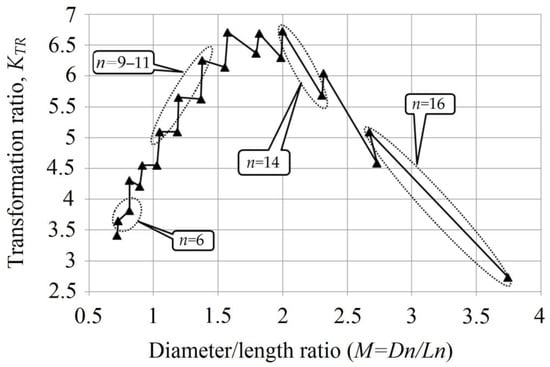
Figure 6.
Dependence of the transformation coefficient of an ultrasonic radiator with gradual transition (KTR = Along/Anut) on the ratio (M = Dn/Ln).
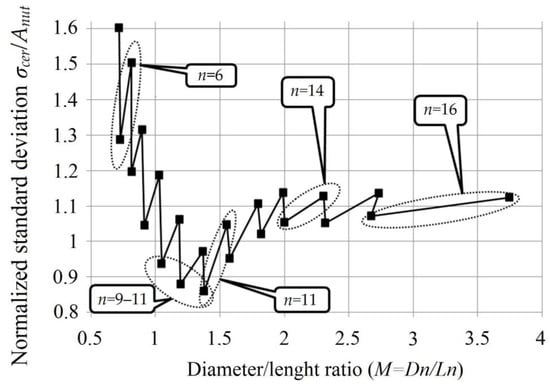
Figure 7.
Dependence of the non-uniformity of the vibration amplitude distribution of piezoceramics (σcer/Anut) with radial transition on the ratio (M = Dn/Ln).
Examples of symmetric amplitude distributions obtained as a result of the modal analysis of constructions are shown in Figure 8.

Figure 8.
Vibration amplitude distribution of the ultrasonic radiator at different ratios (W = R1/Dn).
Analysis of the obtained data establishes that the maximum amplitude of vibrations in the modified radiator design is achieved at n = 12–14 when M = 1.6–2. However, the minimum asymmetry of the piezoceramic vibration distribution is achieved with the dense installation of piezoelectric packets at a number equal to 9–11 at W = 0.27, which is a more important factor influencing the radiator reliability.
It was determined that the smaller the number of piezoelectric packets, the greater the difference between the adjacent NSD values. This is caused by the fact that when the diameter of the summator is small (for example, with the number of piezoelectric packets n = 6, the non-uniformity changes from 1.2 to 1.47), the distance (the gap between adjacent piezoelectric packets) changes significantly. In comparison with the larger diameter (with the number of piezoelectric packets n = 16, the non-uniformity changes from 1.08 to 1.12), a change in the number of piezoelectric packets by 1 does not significantly affect the gap between the packets. Meanwhile, the presence of large gaps between the piezoelectric packets on the summator causes asymmetric bending vibrations of the connecting surfaces, which leads to additional bending of the piezoceramic elements.
4. Results of Experimental Research
To confirm the results of modeling and verify the performance of the developed design and symmetrical arrangement of piezoelectric packets, an ultrasonic radiator was manufactured with an operating frequency of 30 kHz, a number of piezoelectric packets of n = 11, and a radial transition of W = 0.27, at which R = 40 mm. Standard piezoceramic elements of size 35 × 16 × 6 mm were used.
Further research was aimed at measuring the limiting power characteristics of the ultrasonic radiator and conducting resource tests during its operation as a part of vibrating systems designed to implement technological processes in liquid media.
For this purpose, the electrical power supply of Langevin transducers was carried out by means of an electronic generator with independent excitation and a phase-locked-loop of frequency. The generator was previously developed by the authors of the article [20,21]. At the output of the generator, a transistor half-bridge and coordinating LC circuit were installed.
The electrical power consumed by the ultrasonic radiator was measured. The measurements were made with a GWINSTEK GPM-8212 model. The power consumption was measured in idle mode as well as with the load (radiation in water) at the maximum amplitude of vibrations.
The power consumed by the developed radiator was determined using the following expression:
where PS—total power consumption and PG—power consumption of the electronic generator without a connected radiator, W.
PE = PS − PG,
To determine the maximum power of the developed radiator, settled main water was used as an acoustic load. A half-wavelength cylinder (with a natural vibration frequency of 29.95 kHz and a diameter of 66 mm) designed for the corresponding frequencies was used as a working instrument immersed in water. Measurements of power consumption were carried out with a fully immersed cylindrical instrument. The colorimetric method [22] was used to measure the power of acoustic vibration output in water. To measure the maximum values of the vibration amplitude, a stroboscopic method was used [23,24,25].
Table 3 summarizes the results of measurements of the power characteristics of the optimized radiator with a symmetrical arrangement of piezoelectric elements.

Table 3.
The results of the measurement of the transducer power characteristics.
The measurement results showed that the design optimization providing symmetric vibrations of the piezoelectric packets provided a 17% increase in the main power characteristics, while increasing the efficiency by 15–78%.
In addition, resource tests and inspection of the radiator elements showed that all piezoceramic elements were not destroyed even after 1000 hours of operation.
Therefore, at the summation of vibrations from 9 to 11 symmetrically arranged Langevin transducers at a resonant frequency of 30.05 kHz with an amplitude of vibrations of 26 µm, an acoustic power (continuous mode) of 1450 W at an efficiency of 78% was achieved.
5. Conclusions
It was found that the summation of the vibrations of individual Langevin transducers symmetrically arranged on a cylindrical radiating element, which provides the transformation of summed diametric vibrations into longitudinal ones, can ensure the creation of powerful high-frequency radiators.
The results of the theoretical and experimental investigations allowed us to propose a way to optimize high-frequency radiators to reduce the probability of their failure and to provide the required symmetry of the vibration amplitude distribution of piezoceramic elements.
It was established that at summations of vibrations from 9 to 11 symmetrically arranged Langevin transducers and radial transition to the summator at the resonance frequency of 30.05 kHz and a vibration amplitude of 26 µm, an acoustic power (continuous mode) of 1450 W at an efficiency of 78% was achieved.
Author Contributions
Data curation, V.N.K. and A.V.S.; formal analysis, A.V.S.; investigation, V.N.K., A.V.S., V.A.N. and A.S.B.; methodology, V.N.K. and V.A.N.; project administration, V.N.K.; validation, V.N.K. and A.V.S.; visualization, V.A.N.; writing—original draft, V.A.N.; writing—review and editing, V.A.N. and A.S.B. All authors have read and agreed to the published version of the manuscript.
Funding
The study was carried out with a grant from the Russian Science Foundation. (Project No. 19-19-00121), https://rscf.ru/en/project/19-19-00121/, accessed on 3 January 2023.
Conflicts of Interest
The authors declare no conflict of interest.
References
- Riera, E.; Golás, Y.; Blanco, A.; Gallego-Juárez, J.A.; Blasco, M.; Mulet, A. Mass transfer enhancement in supercritical fluids extraction by means of power ultrasound. Ultrason. Sonochem. 2004, 11, 241–244. [Google Scholar] [CrossRef] [PubMed]
- Fan, F.; Zhang, S.; Wang, W.; Yan, J.; Su, M. Numerical investigation of PM2.5 size enlargement by heterogeneous condensation for particulate abatement. Process Saf. Environ. Prot. 2019, 125, 197–206. [Google Scholar] [CrossRef]
- Sarabia, E.; Gallego-Juarez, J.A.; Rodrigues-Corral, G.; Elvira-Segura, L.; Gonzalez-Gomaz, I. Application of high-power ultrasound enhance fluid/solid particle separation processes. Ultrasonics 2000, 38, 642–646. [Google Scholar] [CrossRef] [PubMed]
- Kuzovnikov, Y.M.; Khmelev, S.S.; Tsyganok, S.N.; Khmelev, V.N. Studying of coagulation and sedimentation of small hard particles in liquid medium during ultrasonic treatment. In Proceedings of the EDM’2010: Conference, Erlagol, Russia, 30 June–4 July 2010; NSTU: Novosibirsk, Russia, 2010; pp. 281–284. [Google Scholar] [CrossRef]
- Avvaru, B.; Patil, M.N.; Gogate, P.R.; Pandit, A.B. Ultrasonic atomization: Effect of liquid phase properties. Ultrasonics 2006, 44, 146–158. [Google Scholar] [CrossRef]
- Ajay, M.; Anand, T.N. Study of ultrasonic atomization. In Proceedings of the ILASS ASIA 2013, Nagasaki, Japan, 18–19 December 2013. [Google Scholar] [CrossRef]
- Transducer, B.L.; Takahashi, T.; Adachi, K. Influence of static prestress on the characteristics of bolt-clamped Langevin-type transducers. Jpn. J. Appl. Phys. 1998, 37, 2982–2987. [Google Scholar] [CrossRef]
- Adachi, K.; Konno, Y.; Masaki, S. Development of bolt-clamped Langevin-type transducer factor for excitation of large torsional vibration with high mechanical quality. Jpn. J. Appl. Phys. 1994, 33, 1182–1188. [Google Scholar] [CrossRef]
- Abdullah, A.; Shahini, M.; Pak, A. An approach to design a high power piezoelectric ultrasonic transducer. J. Electroceram. 2009, 22, 369–382. [Google Scholar] [CrossRef]
- Shahini, M.; Abdullah, A.; Rezaei, M. Design and Manufacture of an Ultrasonic Transducer with 1 kW Power and 22 kHz Frequency Using Piezoceramics. Master’s Thesis, Faculty of Mechanical Engineering, AmirKabir University of Technology, Tehran, Iran, 2004. [Google Scholar]
- Lin, S. Study on the Langevin piezoelectric ceramic ultrasonic transducer of longitudinal–flexural composite vibrational mode. Ultrasonics 2006, 44, 109–114. [Google Scholar] [CrossRef]
- Lin, S.; Zhang, F. Measurement of ultrasonic power and electro-acoustic efficiency of high power transducers. Ultrasonics 2000, 37, 549–554. [Google Scholar] [CrossRef]
- APC International Ltd. Piezoelectric Ceramics: Principles and Applications; APC International Ltd.: Mackeyville, PA, USA, 2002. [Google Scholar]
- Lin, S.; Xu, L.; Wenxu, H. A new type of high power composite ultrasonic transducer. J. Sound Vib. 2011, 330, 1419–1431. [Google Scholar] [CrossRef]
- Lais, H.; Lowe, P.S.; Gan, T.H.; Wrobel, L.C. Numerical modelling of acoustic pressure fields to optimize the ultrasonic cleaning technique for cylinders. Ultrason. Sonochem. 2018, 45, 7–16. [Google Scholar] [CrossRef] [PubMed]
- Wei, X.; Yang, Y.; Yao, W.; Zhang, L. PSpice Modeling of a Sandwich Piezoelectric Ceramic Ultrasonic Transducer in Longitudinal Vibration. Sensors 2017, 17, 2253. [Google Scholar] [CrossRef] [PubMed]
- Gallego-Juarez, J.A.; Rodriguez, G.; Acosta, V.; Riera, E. Power ultrasonic transducer with extensive radiator for industrial processing. Ultrason. Sonochem. 2010, 17, 954–964. [Google Scholar] [CrossRef]
- Berlincourt, D.A.; Curran, D.R.; Jaffe, H. Piezoelectric and Piezomagnetic Materials and Their Function in Transducers. Phys. Acoust. 1964, 1, 169–270. [Google Scholar] [CrossRef]
- Piezoelectric Ceramic Products. Fundamentals, Characteristics and Applications; PI Ceramic: Lederhose, Germany, 2015. [Google Scholar]
- Khmelev, V.N.; Barsukov, R.V.; Tsyganok, S.N.; Steer, V.N.; Shalunov, A.V.; Lebedev, A.N. Adjusting and calibration electronic ultrasonic generators. In Proceedings of the Siberian Russian Workshop on Electron Devices and Materials: Conference, Erlagol, Russia, 1–3 July 2003; Institute of Electrical and Electronics Engineers (IEEE): Piscataway, NJ, USA, 2003; pp. 202–204. [Google Scholar] [CrossRef]
- Sultanova, S.A.; Safarov, J.E.; Useno, A.B.; Samandarov, D.I. Study of the design of ultrasonic electronic generators. Technovation 2021, 3, 216–224. [Google Scholar]
- Khmelev, V.N.; Tsyganok, S.N.; Barsukov, R.V.; Lebedev, A.N. A system of a automatic measurement of acoustic power of the ultrasonic equipment. In Proceedings of the International Siberian Workshop on Elctron Devices and Materials, Erlagol, Russia, 1–5 July 2004; Institute of Electrical and Electronics Engineers (IEEE): Piscataway, NJ, USA, 2004; pp. 205–206. [Google Scholar] [CrossRef]
- Kazancev, I.V.; Lebedev, A.N.; Abramenko, D.S. The method of oscillations amplitude measuring. In Proceedings of the 8th Siberian Workshop on Elctron Devices and Materials, Erlagol, Russia, 1–5 July 2007; Institute of Electrical and Electronics Engineers (IEEE): Piscataway, NJ, USA, 2007; pp. 282–284. [Google Scholar] [CrossRef]
- Leonov, G.V.; Khmelev, V.N.; Savin, I.I.; Abramenko, D.S. Automation of the amplitude measurement process of ultrasonic oscillatory systems irradiating surface. In Proceedings of the 6th Siberian Workshop on Elctron Devices and Materials, Erlagol, Russia, 1–5 July 2005; Institute of Electrical and Electronics Engineers (IEEE): Piscataway, NJ, USA, 2005; pp. 64–67. [Google Scholar] [CrossRef]
- Khmelev, V.N.; Levin, S.V.; Abramenko, D.S.; Khmelev, S.S.; Tsyganok, S.N. Control of vibration amplitude and its distribution at the design and operation of multi half-wave vibrating systems. In Proceedings of the International Conference and Seminar of Young Specialists on Micro/Nanotechnologies and Electron Devices, Erlagol, Russia, 2–6 July 2012; NSTU: Novosibirsk, Russia, 2012; pp. 145–147. [Google Scholar] [CrossRef]
Disclaimer/Publisher’s Note: The statements, opinions and data contained in all publications are solely those of the individual author(s) and contributor(s) and not of MDPI and/or the editor(s). MDPI and/or the editor(s) disclaim responsibility for any injury to people or property resulting from any ideas, methods, instructions or products referred to in the content. |
© 2023 by the authors. Licensee MDPI, Basel, Switzerland. This article is an open access article distributed under the terms and conditions of the Creative Commons Attribution (CC BY) license (https://creativecommons.org/licenses/by/4.0/).